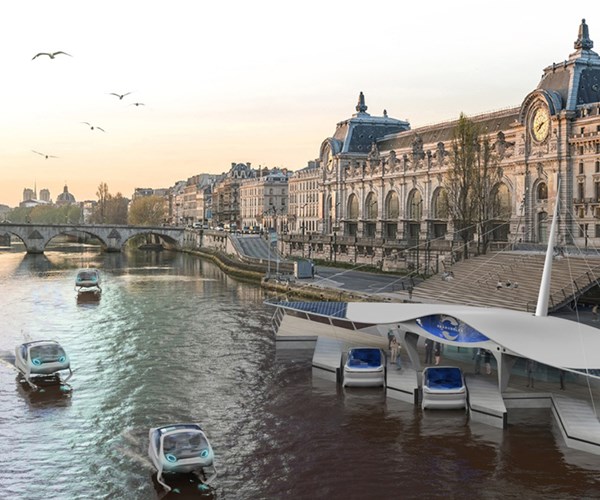Coming soon to the urban waterways: SeaBubbles
All-composite hydrofoiling watercraft will, if SeaBubbles has its way, soon be taxiing people across urban waterways in more than 50 cities across the world.

SeaBubbles concept, Paris, France.
SeaBubbles (Paris, France) is a company and a project. The project is the brainchild of hydrofoiling yachtsman Alain Thébault and champion windsurfer Anders Bringdal. Their vision of creating an eco-conscious taxi transport solution for the world’s urban waterways has come to fruition with the support of composites Décision SA (Ecublens, Switzerland) and Sicomin Epoxy Systems (Chateauneuf les Martigues, France) a formulator and supplier of high-performance epoxy systems.
SeaBubbles are based on a hydrofoil design that allows the watercraft to glide silently above the water when it exceeds 12 kph/7.5 mph. A clean charging electric drive system converts solar, wind and water power so the vessel does not generate any CO2 emissions.
Décision SA, part of the Carboman group, working with SeaBubbles and Sicomin, has so far completed the first of five SeaBubbles water taxi prototypes and these were launched in June 2017 on the River Seine in Paris. The boats were delivered in record time with material specification, design analysis and production achieved in less than four months. Décision is now on track to produce the remaining four prototypes that will also be in service in Paris starting in September 2017.
Décision faced a particularly daunting challenge with this project in that it was particularly important to focus on future production and not just the initial prototypes. To match the ambitious growth plans of the SeaBubbles team, it was vital to consider a robust, sustainable and cost-effective serial production route from the outset.

SeaBubbles prototype.
Working alongside the SeaBubbles team, Décision analyzed the initial design and delivered production-ready tooling and a production-ready composites manufacturing process.
In addition to satisfying the composite engineering targets for weight and stiffness, Décision’s manufacturing process was also required to include a significant percentage of bio-based materials. For material development, Sicomin was chosen because of its history as a formulator and supplier of a range of bio-based epoxy resins, natural fibers and core materials.
All of the SeaBubbles composite parts are produced using a vacuum infusion process where the sandwich structure comprising of reinforcement fibers and a natural cork core are infused with Sicomin’s GreenPoxy InfuGreen810 advanced resin system.
InfuGreen 810 contains 30% carbon content that is derived from plant-based origins. It also has extremely low viscosity at room temperature. Sicomin has formulated the advanced bio product to support manufacturers producing parts for mass production using injection or infusion techniques and the system is available with a variety of hardeners, making it suitable for small to very large components. InfuGreen 810 also holds DNV GL certification providing extra assurance of the products quality, efficiency and safety standards.
Sicomin also supplied a range of complementary materials to provide a package of infusion-specific products including glass fiber multiaxial fabrics, PVC foams with bespoke perforation patterns for infusion, release agents and epoxy spray adhesives to securely position dry fabrics in the molds.
“SeaBubbles has unified a group of companies with eco-friendly ambitions to create a truly innovative concept in transportation. Décision has been the perfect development customer with their experience of creating exceptional quality and performance parts whilst using a wide range of bio-based epoxy resins, natural fibres and core materials. The SeaBubbles team provided us all with a vision to follow,” comments Philippe Marcovich, president of Sicomin.
SeaBubbles reports it is committed to providing its water taxi service at the cost of regular taxi journey and plans to operate in 50 cities within the next five years. Following on from the success of this first phase of the project, a larger 15-seater vessel is also planned for construction later this year.
Related Content
Prepreg compression molding supports higher-rate propeller manufacturing
To meet increasing UAV market demands, Mejzlik Propellers has added a higher-rate compression molding line to its custom CFRP propeller capabilities.
Read MoreClean Aviation's regional aircraft technology testbed #2 demonstrates advances with composites
European project advances OOA outer wing box using resin infusion and thermoplastic composite technologies.
Read MoreCOMPINNOV TP2 project promotes use of thermoplastics in aerospace
Completed in 2023, COMPINNOV TP2 explored thermoplastic composites, enhancing the understanding between prepregs and production methods to foster the potential for French aerospace innovation.
Read MoreComposite Integration presents webinar on liquid resin infusion
On July 30, 2025, company experts will discuss the role of LRI in delivering scalable, OOA composite production for the aerospace sector.
Read MoreRead Next
Ultrasonic welding for in-space manufacturing of CFRTP
Agile Ultrasonics and NASA trial robotic-compatible carbon fiber-reinforced thermoplastic ultrasonic welding technology for space structures.
Read MoreCutting 100 pounds, certification time for the X-59 nose cone
Swift Engineering used HyperX software to remove 100 pounds from 38-foot graphite/epoxy cored nose cone for X-59 supersonic aircraft.
Read MoreNext-gen fan blades: Hybrid twin RTM, printed sensors, laser shock disassembly
MORPHO project demonstrates blade with 20% faster RTM cure cycle, uses AI-based monitoring for improved maintenance/life cycle management and proves laser shock disassembly for recycling.
Read More












